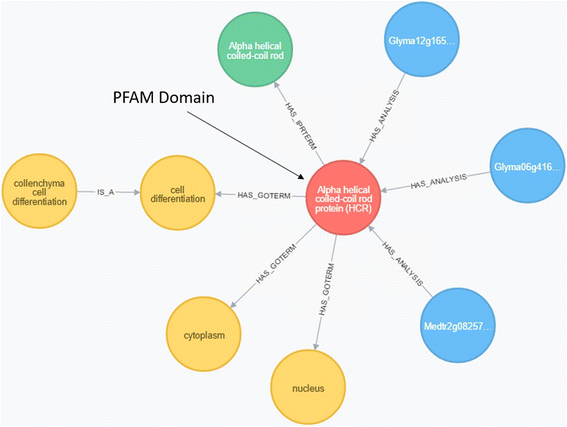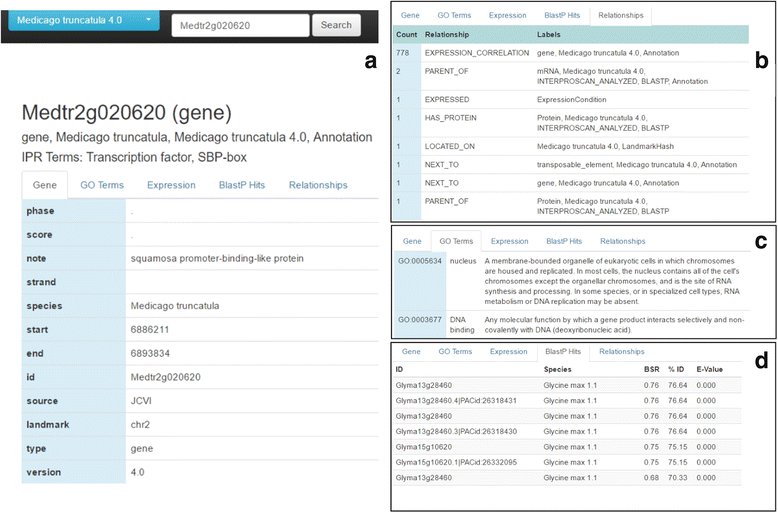ODG: Omics database generator - a tool for generating, querying, and analyzing multi-omics comparative databases to facilitate biological understanding
- PMID: 28797229
- PMCID: PMC5553995
- DOI: 10.1186/s12859-017-1777-7
ODG: Omics database generator - a tool for generating, querying, and analyzing multi-omics comparative databases to facilitate biological understanding
Abstract
Background: Rapid generation of omics data in recent years have resulted in vast amounts of disconnected datasets without systemic integration and knowledge building, while individual groups have made customized, annotated datasets available on the web with few ways to link them to in-lab datasets. With so many research groups generating their own data, the ability to relate it to the larger genomic and comparative genomic context is becoming increasingly crucial to make full use of the data.
Results: The Omics Database Generator (ODG) allows users to create customized databases that utilize published genomics data integrated with experimental data which can be queried using a flexible graph database. When provided with omics and experimental data, ODG will create a comparative, multi-dimensional graph database. ODG can import definitions and annotations from other sources such as InterProScan, the Gene Ontology, ENZYME, UniPathway, and others. This annotation data can be especially useful for studying new or understudied species for which transcripts have only been predicted, and rapidly give additional layers of annotation to predicted genes. In better studied species, ODG can perform syntenic annotation translations or rapidly identify characteristics of a set of genes or nucleotide locations, such as hits from an association study. ODG provides a web-based user-interface for configuring the data import and for querying the database. Queries can also be run from the command-line and the database can be queried directly through programming language hooks available for most languages. ODG supports most common genomic formats as well as generic, easy to use tab-separated value format for user-provided annotations.
Conclusions: ODG is a user-friendly database generation and query tool that adapts to the supplied data to produce a comparative genomic database or multi-layered annotation database. ODG provides rapid comparative genomic annotation and is therefore particularly useful for non-model or understudied species. For species for which more data are available, ODG can be used to conduct complex multi-omics, pattern-matching queries.
Keywords: Annotation; Comparative genomics; Data integration; Graph database; Non-model species.
Conflict of interest statement
Ethics approval and consent to participate
Not Applicable.
Consent for publication
Not Applicable.
Competing interests
The authors declare that they have no competing interests.
Publisher’s Note
Springer Nature remains neutral with regard to jurisdictional claims in published maps and institutional affiliations.
Figures





Similar articles
-
CGKB: an annotation knowledge base for cowpea (Vigna unguiculata L.) methylation filtered genomic genespace sequences.BMC Bioinformatics. 2007 Apr 19;8:129. doi: 10.1186/1471-2105-8-129. BMC Bioinformatics. 2007. PMID: 17445272 Free PMC article.
-
TabSQL: a MySQL tool to facilitate mapping user data to public databases.BMC Bioinformatics. 2010 Jun 23;11:342. doi: 10.1186/1471-2105-11-342. BMC Bioinformatics. 2010. PMID: 20573251 Free PMC article.
-
The MOLGENIS toolkit: rapid prototyping of biosoftware at the push of a button.BMC Bioinformatics. 2010 Dec 21;11 Suppl 12(Suppl 12):S12. doi: 10.1186/1471-2105-11-S12-S12. BMC Bioinformatics. 2010. PMID: 21210979 Free PMC article.
-
The Y-ome Conundrum: Insights into Uncharacterized Genes and Approaches for Functional Annotation.Mol Cell Biochem. 2024 Aug;479(8):1957-1968. doi: 10.1007/s11010-023-04827-8. Epub 2023 Aug 23. Mol Cell Biochem. 2024. PMID: 37610616 Review.
-
Analysis of omics data with genome-scale models of metabolism.Mol Biosyst. 2013 Feb 2;9(2):167-74. doi: 10.1039/c2mb25453k. Epub 2012 Dec 18. Mol Biosyst. 2013. PMID: 23247105 Free PMC article. Review.
Cited by
-
Ecosystem-specific microbiota and microbiome databases in the era of big data.Environ Microbiome. 2022 Jul 16;17(1):37. doi: 10.1186/s40793-022-00433-1. Environ Microbiome. 2022. PMID: 35842686 Free PMC article. Review.
-
The Sordariomycetes: an expanding resource with Big Data for mining in evolutionary genomics and transcriptomics.Front Fungal Biol. 2023 Jun 30;4:1214537. doi: 10.3389/ffunb.2023.1214537. eCollection 2023. Front Fungal Biol. 2023. PMID: 37746130 Free PMC article. Review.
-
Development of a knowledge graph framework to ease and empower translational approaches in plant research: a use-case on grain legumes.Front Artif Intell. 2023 Aug 3;6:1191122. doi: 10.3389/frai.2023.1191122. eCollection 2023. Front Artif Intell. 2023. PMID: 37601035 Free PMC article.
-
Chinese Herbal Medicine Hepatotoxicity: The Evaluation and Recognization Based on Large-scale Evidence Database.Curr Drug Metab. 2019;20(2):138-146. doi: 10.2174/1389200219666180813144114. Curr Drug Metab. 2019. PMID: 30101702 Free PMC article. Review.
-
The complete replicons of 16 Ensifer meliloti strains offer insights into intra- and inter-replicon gene transfer, transposon-associated loci, and repeat elements.Microb Genom. 2018 May;4(5):e000174. doi: 10.1099/mgen.0.000174. Epub 2018 Apr 19. Microb Genom. 2018. PMID: 29671722 Free PMC article.
References
-
- Neo4j: The World’s Leading Graph Database. http://neo4j.com/. Accessed 10 Mar 2017.
MeSH terms
LinkOut - more resources
Full Text Sources
Other Literature Sources
Molecular Biology Databases
Miscellaneous

